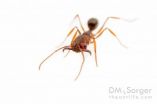(Press-News.org) Sexting among youth is more prevalent than previously thought, according to a new study from Drexel University that was based on a survey of undergraduate students at a large northeastern university. More than 50 percent of those surveyed reported that they had exchanged sexually explicit text messages, with or without photographic images, as minors.
The study also found that the majority of young people are not aware of the legal ramifications of underage sexting. In fact, most respondents were unaware that many jurisdictions consider sexting among minors – particularly when it involves harassment or other aggravating factors – to be child pornography, a prosecutable offense. Convictions of these offenses carry steep punishments, including jail time and sex offender registration.
"This is a scary and disturbing combination," said researcher David DeMatteo, JD, PhD. "Given the harsh legal penalties sometimes associated with youth sexting and the apparent frequency with which youth are engaging in it, the lack of comprehension regarding such penalties poses a significant problem."
The study, entitled "Youth Sexting: Prevalence Rates, Driving Motivations, and the Deterrent Effect of Legal Consequences," was published online in June 2014 by the journal entitled Sexuality Research and Social Policy.
In addition to DeMatteo, an associate professor of psychology and law and director of Drexel's joint JD/PhD program in psychology and law in the College of Arts and Sciences and School of Law, the study was conducted by lead author Heidi Strohmaier, a PhD candidate in psychology at Drexel, and Megan Murphy, a JD/PhD candidate at Drexel.
The study, in which undergraduate students from a large northeastern university completed an anonymous online survey concerning their engagement in sexting as minors, revealed a significant relationship between awareness of legal consequences and sexting behavior as minors.
Those who were aware of the potential legal consequences reported sexting as a minor significantly less than those who were not aware of the legal consequences. Additionally, most respondents who reported being unaware of the potential legal consequences of sexting expressed the belief that they may have been deterred from sexting as a minor if they had known.
The finding that legal consequences may deter youth from sexting has important policy implications, according to the researchers.
In many jurisdictions, the law has yet to catch up with youth sexting behavior and technological advances. Until recently, most states did not have a legal mechanism in place to handle cases of teenage sexting. Instead, they were required to fit this new teenage subculture into the existing legal framework. As a result, youth sexting was often subsumed under laws governing serious child pornography and child exploitation offenses. Convictions of these offenses carry steep punishments, including jail time and sex offender registration—punishments that many lawyers and legislatures have deemed too harsh for adolescent sexting.
While many states have joined the movement toward creating youth sexting legislation, there is currently no federal sexting-specific legislation in the United States.
"It's a major concern that many states do not have laws that specifically address sexting," said DeMatteo. "Sexting specific laws would be beneficial because they – ideally – would clearly define what constitutes sexting and outline potential penalties. To the latter point, these laws would make it possible for judges to avoid imposing overly harsh sentences on those who are prosecuted under sexting laws."
The rapidly changing legal landscape further underscores the need to educate youth about current sexting laws. According to the researchers, an important step in addressing this issue would be to develop educational initiatives aimed at providing basic information to youth about legal consequences of sexting and other negative consequences such as humiliation, a tarnished reputation and bullying/taunting.
"Young people need to be educated about the potential consequences of sexting—legal, social and psychological," DeMatteo said. "The education should come from many sources – the more young people hear the message, the more likely it will be to sink in – so they should be educated by their parents, schools and perhaps even law enforcement."
The study also examined motivations for sexting, the frequency respondents engaged in this behavior, the number of partners with whom they exchanged sexts, gender differences with regard to sexting and opinions about what appropriate consequences should be for engaging in illegal forms of this behavior.
INFORMATION:
About the Researchers:
David DeMatteo's research interests include psychopathy, forensic mental health assessment, drug policy and offender diversion. His research has been funded by the National Institute on Drug Abuse, Pennsylvania Department of Health, Pennsylvania Commission on Crime and Delinquency and American Psychology-Law Society. DeMatteo is licensed as a psychologist in Pennsylvania, where he conducts forensic mental health assessments of juveniles and adults. He has co-authored four books, including "Forensic Mental Health Assessment: a Casebook," now in its second edition from Oxford University Press, as well as numerous book chapters and articles. He is an associate editor of Law and Human Behavior, on the editorial boards of several other journals, and a reviewer for more than 25 scientific journals. He is a fellow of the American Psychological Association, and he is board certified in forensic psychology by the American Board of Professional Psychology.
Megan Murphy is entering her sixth-year in Drexel's JD/PhD program. Her primary research interests include criminal responsibility evaluations; risk assessment; trauma-informed care; and burgeoning areas in forensic psychology, such as forensic animal maltreatment evaluations. Her co-authored publications explore issues such as mandated substance-use treatment, capital sentencing, juvenile justice and women's issues in forensic psychology. Murphy has clinical experience in a range of psychological settings. She has done human rights work in Port-au-Prince with Drexel's Haiti Justice Project and participated in a legal co-op at the Montgomery County Public Defender's Office. Before coming to Drexel, Murphy served as a volunteer coordinator for AmeriCorps "Schools of Hope," addressing educational inequality through literacy tutoring in elementary schools.
Heidi Strohmaier is completing her fourth year in Drexel's doctoral program in clinical psychology. Her primary research emphasis is on forensic issues, including psychopathy, diversion for offenders with mental health and substance use issues, and legislation regarding animal maltreatment and juvenile sex offenders. Strohmaier also has clinical interests in health psychology and PTSD, particularly among veterans. During graduate school, she has completed clinical practica involving assessments and therapy with incarcerated offenders, hospitalized medical patients and adults with social anxiety disorder. She will be completing her pre-doctoral internship at the James Haley VA Medical Center in Tampa, Florida.
About Drexel's JD/PhD Program:
Drexel University's School of Law and College of Arts and Sciences offer a joint and integrated JD/PhD Program in law and psychology. The program melds two already ongoing successful endeavors, the JD degree in the School of Law and the PhD in clinical psychology in the Department of Psychology, thus further enhancing Drexel's leadership in multidisciplinary education. The program provides those students who wish to pursue professional degrees in both law and psychology with a more efficient plan of study. The program is designed to be completed in seven years.
Majority of minors engage in sexting, unaware of harsh legal consequences
2014-06-18
ELSE PRESS RELEASES FROM THIS DATE:
Litter-dwelling thrips live mainly in tropical and subtropical regions
2014-06-18
The species diversity in soil fauna has been studied in temperate regions for more than 50 years, but with scarcely any mention of thrips. This lack of reference to thrips raises the question whether or not litter-dwelling thrips are distributed only in tropical and sub-tropical regions.
To answer this question a total 150 leaf litter samples were collected from 6 natural reserves located in three climatic regions, temperate, subtropical and tropical, along a 4100 km latitudinal gradient in East China. The survey was done over a four-year period by Dr Jun Wang, who is ...
Kids whose time is less structured are better able to meet their own goals
2014-06-18
Children who spend more time in less structured activities—from playing outside to reading books to visiting the zoo—are better able to set their own goals and take actions to meet those goals without prodding from adults, according to a new study by the University of Colorado Boulder.
The study, published online in the journal Frontiers in Psychology, also found that children who participate in more structured activities—including soccer practice, piano lessons and homework—had poorer "self-directed executive function," a measure of the ability to set and reach goals ...
Dismisses link between suicidal behaviour and ADHD drugs
2014-06-18
A new register-based study from Karolinska Institutet in Sweden shows that drug therapy for ADHD does not entail an increased risk of suicide attempts or suicide, as was previously feared. The results are published in the British Medical Journal (BMJ).
"Our work in several ways shows that most likely there is no link between treatment with ADHD drugs and an increased risk of suicide attempts or suicide. The results rather indicate that ADHD drugs may have a protective effect," says Henrik Larsson, researcher at the Department of Medical Epidemiology and Biostatistics, ...
New horned dinosaur reveals unique wing-shaped headgear
2014-06-18
Cleveland, Ohio - Scientists have named a new species of horned dinosaur (ceratopsian) based on fossils collected from Montana in the United States and Alberta, Canada. Mercuriceratops (mer-cure-E-sare-ah-tops) gemini was approximately 6 meters (20 feet) long and weighed more than 2 tons. It lived about 77 million years ago during the Late Cretaceous Period. Research describing the new species is published online in the journal Naturwissenschaften.
Mercuriceratops (Mercuri + ceratops) means "Mercury horned-face," referring to the wing-like ornamentation on its head ...
Spanish slug -- Busting an invasion myth
2014-06-18
Frankfurt am Main, Germany, June 18th 2014. Spanish slugs (Arion lusitanicus) are one of the most common slug species in Central Europe. The animals sometimes nicknamed "killer slugs" are known to do their fair share of damage in fields and gardens. The slug was thought to have originated in Southern Europe. However researchers of the German Biodiversity and Climate Centre and the Goethe University now found out, that the prime example of an invasive species is originally from Central Europe and thus no "immigrant" after all. Control measures, such as the EU regulation ...
New study is first to identify, clarify MERS-related abnormality distribution on CT
2014-06-18
Leesburg, VA, June 18, 2014—Researchers in Saudi Arabia have identified key defining characteristics of Middle East Respiratory Syndrome (MERS) in CT imaging of patients confirmed as having the disease.
The study found that the most common CT finding in hospitalized patients with MERS infection is suggestive of an organizing pneumonia pattern.
"A few studies have described variable degrees of lung opacities in patients with MERS, but did not clearly address their exact distribution," said Amr M. Ajlan, the corresponding author of the study. "Because we evaluated the ...
Study shows cost-effectiveness of smoking cessation counseling during hospitalization
2014-06-18
OTTAWA, June 18, 2014 – In a recent study published in Tobacco Control, researchers at the University of Ottawa Heart Institute have demonstrated the cost-effectiveness of the Ottawa Model for Smoking Cessation (OMSC), an intervention that includes in-hospital counseling, pharmacotherapy and post-hospital follow-up, compared to usual care among smokers hospitalized with acute myocardial infarction, unstable angina, heart failure, and chronic obstructive pulmonary disease.
The study examined patients hospitalized in Ontario, a province with a population of approximately ...
Animals conceal sickness symptoms in certain social situations
2014-06-18
The review's sole author, Dr. Patricia Lopes from the Institute of Evolutionary Biology and Environmental Studies at the University of Zurich, says that animals from a number of different species will eat and drink less, reduce their activity and sleep more when they are sick in order to conserve energy for their recovery. However, this can all change depending on the social situation.
In a paper published this week in the journal Proceedings of the Royal Society B, Lopes reviewed a range of different social situations that affected the behavior of sick animals, including ...
Childhood maltreatment associated with cerebral grey matter abnormalities
2014-06-18
An international study has analysed the association between childhood maltreatment and the volume of cerebral grey matter, responsible for processing information. The results revealed a significant deficit in various late developing regions of the brain after abuse.
According to the World Health Organisation (WHO), child maltreatment is defined as all forms of physical and/or emotional ill-treatment, sexual abuse, neglect or negligent treatment or commercial or other exploitation, resulting in actual or potential harm to the child's health, survival, development or dignity ...
Trap-jaw ants spreading in southeastern United States
2014-06-18
Trap-jaw ant species are active hunters with venomous stings and jaws powerful enough to fling themselves through the air. According to new research, they are also spreading into new territory in the southeastern United States. The research was done by scientists at North Carolina State University, the Mississippi Entomological Museum, the University of California, Davis and Archbold Biological Station.
"The fact that some of these species are spreading is interesting, in part, because these giant ants have managed to expand their territory without anyone noticing," says ...





